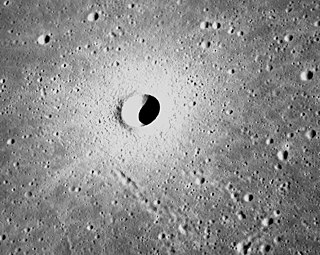
Linné is a small lunar impact crater located in the western Mare Serenitatis. It was named after Swedish botanist Carl Linnaeus. The mare around this feature is virtually devoid of other features of interest. The nearest named crater is Banting to the east-southeast. The estimated age of this copernican crater is only a few tens of millions of years. It was earlier believed to have a bowl shape, but data from the LRO showed that it has a shape of a flattened, inverted cone. The crater is surrounded by a blanket of ejecta formed during the original impact. This ejecta has a relatively high albedo, making the feature appear bright.

In planetary geology, a ray system comprises radial streaks of fine ejecta thrown out during the formation of an impact crater, looking somewhat like many thin spokes coming from the hub of a wheel. The rays may extend for lengths up to several times the diameter of their originating crater, and are often accompanied by small secondary craters formed by larger chunks of ejecta. Ray systems have been identified on the Moon, Earth, Mercury, and some moons of the outer planets. Originally it was thought that they existed only on planets or moons lacking an atmosphere, but more recently they have been identified on Mars in infrared images taken from orbit by 2001 Mars Odyssey's thermal imager.

Ejecta are particles ejected from an area. In volcanology, in particular, the term refers to particles including pyroclastic materials (tephra) that came out of a volcanic explosion and magma eruption volcanic vent, or crater, has traveled through the air or under water, and fell back on the ground surface or on the ocean floor.
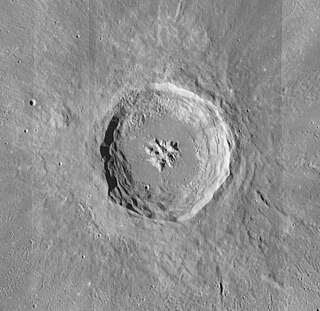
Aristillus is a prominent lunar impact crater that lies in the eastern Mare Imbrium. It was named after Greek astronomer Aristyllus. Directly to the south is the smaller crater Autolycus, while to the southwest is the large Archimedes. To the northeast are the craters Theaetetus and Cassini.

Ashbrook is a large lunar impact crater that is located in the vicinity of the south pole on the far side of the Moon, and so cannot be viewed directly from the Earth. The eastern face of the crater has been overlain by the similar-sized Drygalski, and more than half the interior floor of Ashbrook is covered by the outer ramparts and ejecta of Drygalski. To the northwest is the walled plain Zeeman.

Brashear is a lunar impact crater on the far side of the Moon, in the southern hemisphere in the vicinity of the south pole. The crater is named after the American astronomer John A. Brashear. It lies just to the south of the walled plain Antoniadi, within the larger crater's outer rampart of ejecta. To the northeast besides Antoniadi is the crater Numerov, and southeast lies the younger De Forest.

Blackett is a lunar impact crater that lies on the far side of the Moon, behind the southwest limb. It lies beyond the southeast outer ring of the immense Mare Orientale basin. The formation of that major feature has left Blackett deeply marked with ridge features trending from the northwest. Much of the crater has been shaped by the ejecta from Mare Orientale, particularly along the western half of the crater.

Elvey is a lunar impact crater that is located on the far side of the Moon. It is located near the northern edge of the blanket of ejecta that surrounds the Mare Orientale impact basin. To the north of Elvey is the smaller crater Nobel.
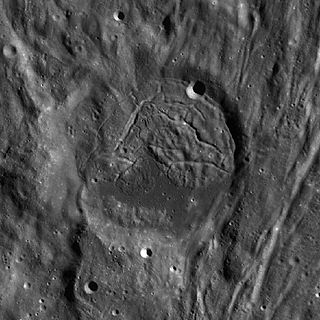
Fényi is a small lunar crater on the far side of the Moon. It lies near the southern edge of the huge, braided skirt of ejecta that surrounds the Orientale impact Basin to the north. Less than two crater diameters to the southwest is the much larger crater Mendel.

Fridman is the remains of a lunar impact crater on the far side of the Moon. It lies due south of the huge walled plain Hertzsprung, and is attached to the northeastern rim of the crater Ioffe.

An ejecta blanket is a generally symmetrical apron of ejecta that surrounds an impact crater; it is layered thickly at the crater's rim and thin to discontinuous at the blanket's outer edge. The impact cratering is one of the basic surface formation mechanisms of the solar system bodies and the formation and emplacement of ejecta blankets are the fundamental characteristics associated with impact cratering event. The ejecta materials are considered as the transported materials beyond the transient cavity formed during impact cratering regardless of the state of the target materials.
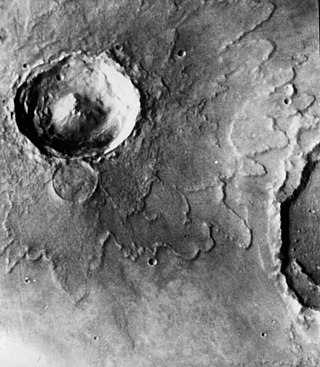
Yuty is a crater on Mars in Chryse Planitia, named after the town of Yuty in Paraguay. It measures approximately 19 kilometres in diameter, and is surrounded by complex ejecta lobes, which are a distinctive characteristic of martian impact craters.

The Tolstoj quadrangle in the equatorial region of Mercury runs from 144 to 216° longitude and -25 to 25° latitude. It was provisionally called "Tir", but renamed after Leo Tolstoy by the International Astronomical Union in 1976. Also called Phaethontias.
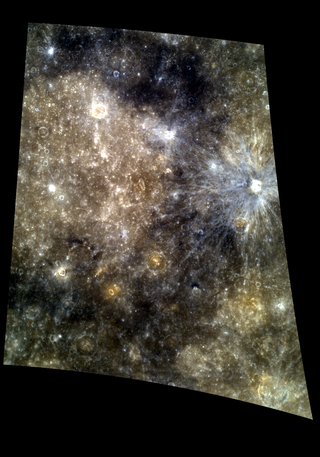
Tolstoj is a large, ancient impact crater on Mercury. It was named after Leo Tolstoy by the IAU in 1976. The albedo feature Solitudo Maiae appears to be associated with this crater.

The Beethoven quadrangle is located in the equatorial region of Mercury, in the center of the area imaged by Mariner 10. Most pictures of the quadrangle were obtained at high sun angles as the Mariner 10 spacecraft receded from the planet. Geologic map units are described and classified on the basis of morphology, texture, and albedo, and they are assigned relative ages based on stratigraphic relations and on visual comparisons of the density of superposed craters. Crater ages are established by relative freshness of appearance, as indicated by topographic sharpness of their rim crests and degree of preservation of interior and exterior features such as crater floors, walls, and ejecta aprons. Generally, topography appears highly subdued because of the sun angle, and boundaries between map units are not clearly defined.
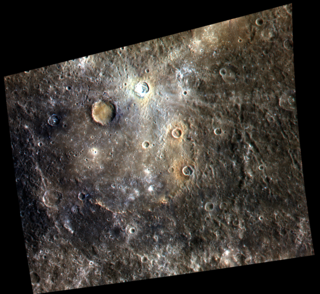
Homer is a crater on Mercury. It is one of 110 peak ring basins on Mercury. It is Tolstojan in age.

Puńsk is an impact crater on Mars, located in the Oxia Palus quadrangle at 20.8° N and 41.2° W. It measures 11.6 kilometers in diameter and was named after the village of Puńsk in Poland.
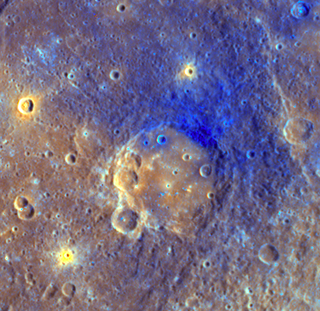
Titian is an impact crater on the planet Mercury. It was named by the IAU in 1976.

Hargraves is a Hesperian-age complex double-layered ejecta impact crater on Mars. It was emplaced near the crustal dichotomy in the vicinity of the Nili Fossae, the Syrtis Major volcanic plains, and the Isidis impact basin, and is situated within the Syrtis Major quadrangle. Hargraves has been the target of focused study because its ejecta apron is particularly well-preserved for a Martian crater of its size. It has been analogized to similar double-layered ejecta blankets on Earth, including that of the Ries impact structure, which was where the conceptual model for how such craters formed was first advanced.



















